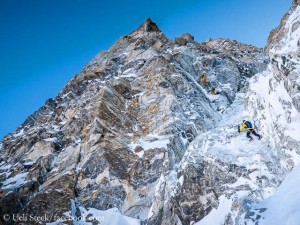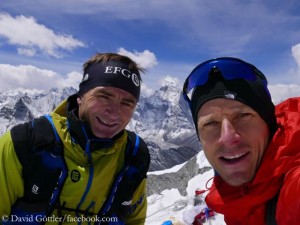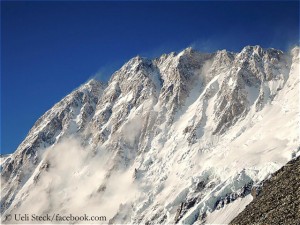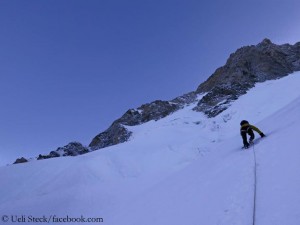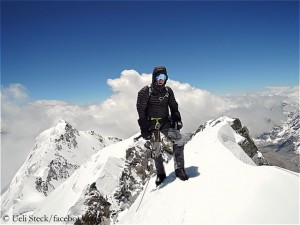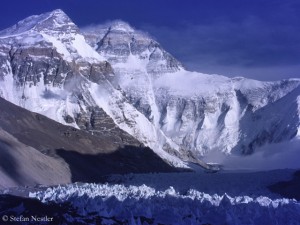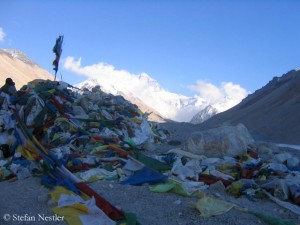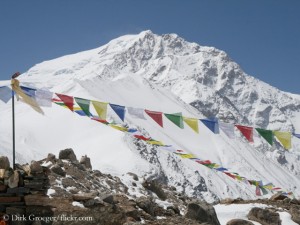Steck and Goettler after Shishapangma South Face: “Only postponed”
It was one of the most exciting climbing projects of this spring’s season in the Himalayas. Swiss top climber Ueli Steck and German David Goettler initially planned to open a new direct route through the South Face of 8,027-meter-high Shishapangma. But they were not able to put it into practice. They “only” climbed the so called “Corredor Girona” route, opened by a Spanish team in 1995, up to the ridge at 7,800 meters and in their last attempt the route of the British first-ascenders of the South Face in 1982, Doug Scott, Alex MacIntyre and Roger Baxter-Jones, up to 7,600 meters. Even though they failed to climb a new route, Ueli and David didn’t return empty-handed from Tibet. I called the 39-year-old Swiss and the 37-year-old German in their hotel in the Nepalese capital Kathmandu.
Satisfied, disappointed or some of both? How do you feel after this expedition?
(David) More satisfied. Of course, you think: If the weather and the conditions had been a bit more on our side, we certainly would have reached the summit. This is slightly shining through. But the more time passes, the more positive is our view on the expedition. We have learned a lot, we were constantly on the move, we were not sitting idle. Compared with other expeditions, we’ve done a lot.
Actually you had planned to climb a new route through Shishapangma South Face. What was the main reason that you failed?
(Ueli) If you want to make such a first ascent, you need stable weather for at least two to three days. But we just never had. If you try it nevertheless, maybe you are able to climb 300, 400 meters high but then you have to abseil again. Therefore, it was unrealistic. But you must be clear about it: If you want to make a first ascent on an eight-thousander, in such a wall, many things must fit together. You must also have the courage to go there more than once, to try again and again and wait for good fortune.
When you were at the foot of the wall for the first time, you told me that the conditions were looking really good. When did you realize that it would not be possible?
(David) Actually until the end, the last weather window around 22 May, we had the option to start climbing the route, if there had been three or four days of good weather. To the end we had deposited all our climbing equipment in ABC (Advanced Base Camp). And til the end we believed it would be possible. When we were at the foot of the wall for the first time, the conditions looked really perfect. There was only too much wind and it was brutally cold. Towards the end of the expedition, before the last weather window, it proved to be just too unstable. Even Karl (Gabl, meteorologist from Austria), who provided us the weather reports, said he had never experienced such a wet and unstable pre-monsoon time in Tibet – on the side of the Himalayas, on which it is normally rather dry. So, actually this dream disappeared at the end.
At your last attempt, you chose the route of the British climbers who first climbed the South Wall. Had you already written off the new route at the time?
(Ueli) At the end the weather window lasted just only half a day. So the decision was clear to focus on the British route. At this time, we did not know whether we might stay longer. Theoretically, we could have waited for another weather window until the end of the month. But in the end it made no sense.
Quick and light – that was your tactics. What does it presuppose?
(Ueli) First of all, the basic fitness of both must be right, otherwise it’s impossible. If you are not trained enough to climb 2,000 meters high at this altitude and in this technical area, it is impossible. But you must also be willing to play the game uncompromisingly. There is no “Maybe I’ll take even a sleeping bag and a stove with me”, so that you could still bivouac. You have to be able to say: We don’t take anything with us, maybe it works or not. You must also be aware of how exposed you are. Both times we were forced to decide: Now we have to descend, otherwise it will be uncomfortable and dangerous. You are limited. You can not just wait and go to the summit the next day.
Except for you, no one was on the south side of Shishapangma. Did you enjoy the solitude?
(David) That was really one of the very special things on this eight-thousander expedition. The Base Camp lies on a meadow with a small lake in front of it, an awesome beautiful place. And we had it for ourselves. We also did not have this pressure when several teams are climbing the same route on a mountain, what can influence each other in their decisions and easily leads to more pressure. Being without all this, has been really luxury for both of us. We enjoyed it very much.
You have been together on the road for two months now. Under these circumstances it’s possible to jar on each other’s nerves. Did you ever have a kind of cabin fever?
(David) No, it was totally relaxed. We got on well because we work very similar in many ways, and because we were always on the move. On our rest days, Ueli bouldered, I did Yoga. So everyone let off steam. And then we went back to the mountain. There were almost no days when we were sitting idle so that a cabin fever could have occurred. For me, it was something new on an expedition to be always on the move. For Ueli it’s normal. But I think he enjoyed it too.
Have you postponed or canceled your project of a new route through Shishapangma South Face?
(Ueli) Never say never! If you want to do something like this, you must have the courage and accept that it is necessary to keep the ball and that it probably will not work the first time. I would rather say it is postponed.
Have you grown as a team so close that you say: We will do it once again?
(David) Yes, for my part. (Both laugh)
(Ueli) It was awesome. We were together on expedition for the first time, and it worked so brilliant. We will hopefully make many more expeditions together. I’ve rarely experienced that it worked so well with a partner and, moreover, both have the same attitude.



